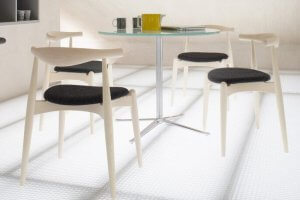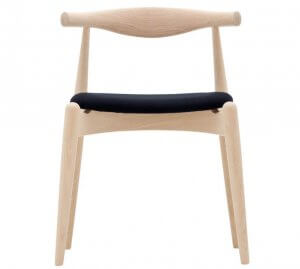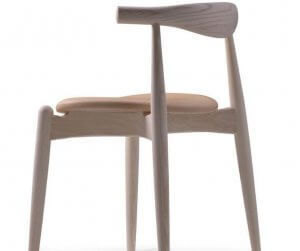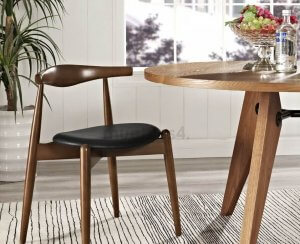Hans Jørgensen Wegner's CH20 Chair

Throughout the history of interior design, there have been fantastic creations that have transformed simple pieces of furniture into unique works of art. One such creation is Hans Jørgensen Wegner’s CH20 Chair.
Also known as the Elbow chair, the CH20 quickly gained popularity on an international level. In fact, you may even have used one yourself, without realizing its significance. This simple design is not only a work of art, but it’s also entirely original.
However, its unusual format means that the CH20 chair is not a common sight in family homes. While families tend to choose practical furniture, this innovative chair has been designed to break with the norm, offering a different aesthetic to the furniture we normally see on the mainstream market.
Who is Hans J. Wegner?

Hans J. Wegner was born in Tønder, Denmark. A carpenter by trade, he graduated from the Copenhagen Art & Crafts School. From a young age, he showed a great interest in the world of interior design and quickly began creating his own innovative works.
His designs are typically Scandinavian in style while using wood to offer a more original aesthetic. His carved wooden furniture demonstrates his in-depth knowledge and mastery of the material and shows the rest of the world what the search for perfection is all about.
With its simple, elegant lines, the CH20 Chair is a clear example of the avant-garde style. Take a closer look, and you’ll see that these chairs are a reflection of modernity, which has been simplified and crystallized into this unique piece of furniture.
Hans J. Wegner’s designs unite art, craftsmanship and carpentry.
5 fundamental features of the CH20 Chair

If we had to describe the CH20 in two words, we would say elegance and lightness. Both of these concepts are reflected in the design, giving the Elbow Chair its distinctive style. Let’s take a look at some of the main features:
1. The first thing that springs to mind when you see the CH20 Chair is the idea of lightness. From backrest to legs, every inch of this chair has been designed to be slim and elegant. Wegner has created an open format which, in turn, helps make rooms feel more open and spacious.
2. The seat is upholstered with comfortable faux-leather material. However, it’s important to remember that the CH20 is not meant for prolonged use; this is a practical piece of furniture that helps give rooms that distinctive minimalist feel.
3. Wegner has tried to soften the lines, creating a sense of fragility while losing none of the strength and durability of the wood. There are no sharp corners – the wood has been sanded and polished to give it a simple, yet defined silhouette.
4. Curved lines reign supreme here. This gives the CH20 a more dynamic and agile appearance, making it an attractive addition to any room.
5. The chair itself is made from pale ash wood, although it is also available in walnut and oak. Walnut is much easier to work with, allowing Wegner to demonstrate his expert carpentry skills.
Where can you buy the CH20 Chair?

Needless to say, the internet is a fantastic tool and opens up a whole new world of possibilities when it comes to buying furniture and decorative elements. You can buy the CH20 Chair from a number of different websites, such as Amazon, as well as Jergen’s own website.
Although it is less common, you can also find it in some specialist design stores. However, because it is such a unique piece, it’s usually cheaper to buy it online and have it delivered straight to your door. This is the simplest and most convenient way to get your hands on one of these bespoke items.
Which styles work best with the CH20 Chair?

Wegner’s creations demonstrate the true essence of the Scandinavian style. The iconic CH20 Elbow chair is not only a reflection of the world of interior design but also of his own personality.
The CH20 Chair works perfectly with minimalist, avant-garde or contemporary style homes – in other words, those modern styles that are always in search of innovation.
Throughout the history of interior design, there have been fantastic creations that have transformed simple pieces of furniture into unique works of art. One such creation is Hans Jørgensen Wegner’s CH20 Chair.
Also known as the Elbow chair, the CH20 quickly gained popularity on an international level. In fact, you may even have used one yourself, without realizing its significance. This simple design is not only a work of art, but it’s also entirely original.
However, its unusual format means that the CH20 chair is not a common sight in family homes. While families tend to choose practical furniture, this innovative chair has been designed to break with the norm, offering a different aesthetic to the furniture we normally see on the mainstream market.
Who is Hans J. Wegner?

Hans J. Wegner was born in Tønder, Denmark. A carpenter by trade, he graduated from the Copenhagen Art & Crafts School. From a young age, he showed a great interest in the world of interior design and quickly began creating his own innovative works.
His designs are typically Scandinavian in style while using wood to offer a more original aesthetic. His carved wooden furniture demonstrates his in-depth knowledge and mastery of the material and shows the rest of the world what the search for perfection is all about.
With its simple, elegant lines, the CH20 Chair is a clear example of the avant-garde style. Take a closer look, and you’ll see that these chairs are a reflection of modernity, which has been simplified and crystallized into this unique piece of furniture.
Hans J. Wegner’s designs unite art, craftsmanship and carpentry.
5 fundamental features of the CH20 Chair

If we had to describe the CH20 in two words, we would say elegance and lightness. Both of these concepts are reflected in the design, giving the Elbow Chair its distinctive style. Let’s take a look at some of the main features:
1. The first thing that springs to mind when you see the CH20 Chair is the idea of lightness. From backrest to legs, every inch of this chair has been designed to be slim and elegant. Wegner has created an open format which, in turn, helps make rooms feel more open and spacious.
2. The seat is upholstered with comfortable faux-leather material. However, it’s important to remember that the CH20 is not meant for prolonged use; this is a practical piece of furniture that helps give rooms that distinctive minimalist feel.
3. Wegner has tried to soften the lines, creating a sense of fragility while losing none of the strength and durability of the wood. There are no sharp corners – the wood has been sanded and polished to give it a simple, yet defined silhouette.
4. Curved lines reign supreme here. This gives the CH20 a more dynamic and agile appearance, making it an attractive addition to any room.
5. The chair itself is made from pale ash wood, although it is also available in walnut and oak. Walnut is much easier to work with, allowing Wegner to demonstrate his expert carpentry skills.
Where can you buy the CH20 Chair?

Needless to say, the internet is a fantastic tool and opens up a whole new world of possibilities when it comes to buying furniture and decorative elements. You can buy the CH20 Chair from a number of different websites, such as Amazon, as well as Jergen’s own website.
Although it is less common, you can also find it in some specialist design stores. However, because it is such a unique piece, it’s usually cheaper to buy it online and have it delivered straight to your door. This is the simplest and most convenient way to get your hands on one of these bespoke items.
Which styles work best with the CH20 Chair?

Wegner’s creations demonstrate the true essence of the Scandinavian style. The iconic CH20 Elbow chair is not only a reflection of the world of interior design but also of his own personality.
The CH20 Chair works perfectly with minimalist, avant-garde or contemporary style homes – in other words, those modern styles that are always in search of innovation.
All cited sources were thoroughly reviewed by our team to ensure their quality, reliability, currency, and validity. The bibliography of this article was considered reliable and of academic or scientific accuracy.
- Pesudo Chiva, María Carmen: Formas curvas alabeadas, Cultivalibros, 2009.







